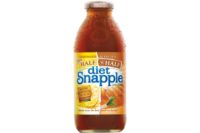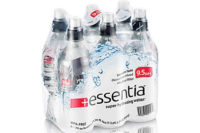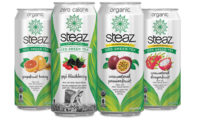Tea competes for share
Premium brands, myriad varieties entice consumers

Single-cup tea pods, such as Celestial Seasoning’s options for Green Mountain Coffee Roaster’s Keurig brewing system, might help the bagged and loose tea category rebound, according to a report from Mintel.

During the recession, The Coca-Cola Co. introduced family-size packaging for its Gold Peak tea brand, and also placed the brand in the refrigerated section for better visibility.

The popularity of lemonade-and-tea drinks have crossed over into the alcohol category, including Anheuser-Busch’s new Michelob Ultra 19th Hole Light Tea & Lemonade.

Designed for the creative mind, Possibiliteas loose teas combine herbal, green, oolong and black tea varieties with other ingredients to provide functional benefits.




When it comes to tea, the more “colorful” the better. Green, black, white and red teas remain popular varietals, while numerous flavor options, health benefits and positionings have helped to propel the category even further, according to experts.
Last year, sales of tea and ready-to-drink (RTD) tea increased 5.1 percent, reaching $4.3 billion in food, drug, convenience stores and mass merchandisers, excluding Walmart, according to Mintel’s July 2011 “Tea and RTD Teas – U.S.” report. Canned and bottled tea as well as refrigerated RTD tea drove growth in the category, the Chicago-based market research firm reported.
The canned and bottled RTD tea segment accounted for just more than 50 percent of the market share in the respective channels and showed the largest growth in the category from 2009 to 2011 at 19.2 percent, Mintel noted. The second-largest segment, refrigerated RTD tea, made up 13 percent of total category sales in 2011 and grew more than 15 percent from 2009 to 2011, the report notes. Bagged and loose tea sales growth remained small compared to the RTD segment, increasing 3.5 percent from 2009 to 2011.
Instant tea mixes performed the worst in the category, declining 8.1 percent from 2009 to 2011, the report states. Mintel does not expect the segment to recover, predicting a 13 percent decline from 2011 to 2016. In order to succeed in the instant tea segment, manufacturers will need to introduce mixes from brands that have established themselves in the RTD tea segment, the Mintel report suggests. Additionally, growth opportunities might be present among the African-American and Hispanic communities because both groups exhibit higher-than-average household consumption of instant tea mixes, according to the report. African-American consumers also report drinking RTD iced tea more often than the average, it adds.
Options abound
Consumers are looking for healthier alternatives to soft drinks, says Richard Haffner, head of beverages research with Euromonitor International, Chicago. Tea can offer a healthy solution and RTD tea is a convenient format that delivers it, he says.
In the RTD tea segment, lemonade-and-tea drinks have gained in popularity. Both Snapple and Sweet Leaf launched lemonade-and-tea beverages this year. Dr Pepper Snapple Group, Plano, Texas, launched Snapple Diet Half ‘n Half Lemonade Iced Tea, a blend of lemonade and iced tea made with green and black tea, and Stamford, Conn.-based Nestlé Waters North America’s Sweet Leaf subsidiary launched Organic Half & Half Lemonade Tea.
The lemonade-and-tea flavors also have crossed over into the alcohol category. This year, St. Louis-based Anheuser-Busch, a wholly owned subsidiary of Anheuser-Busch InBev, expanded its Michelob Ultra beer brand with the limited-edition launch of Ultra 19th Hole Light Tea & Lemonade. The flavored malt beverage (FMB) contains 4 percent alcohol by volume, natural flavors and is sweetened with stevia-derived rebiana-A, making it a lighter alternative to traditional FMBs, the company says. Late last year, Cincinnati-based Arizona Beverage Co. launched an FMB that merges tea and lemonade called Arnold Palmer Hard.
Superfruit flavors, such as pomegranate, acai and goji berry, also are being added to tea drinks to enhance their health and wellness properties, Haffner says. However, lemon remains the top flavor in the tea category, says Garima Goel Lal, senior beverage analyst at Mintel.
“There’s also other additives going [into teas] such as vitamins and stimulants, [which are] looking to segment the category along two lines: one is health properties, and the other is tea has caffeine so it can be a stimulant, so looking to make a more healthy appeal to an energy-type drink,” Haffner says.
Tea manufacturers are marketing the various health benefits of tea consumption, such as its reported effect on lowering cholesterol, and herbal teas are experiencing success as consumers increasingly use them for at-home medicinal remedies, said Los Angeles-based IBISWorld industry analyst Agata Kaczanowska in a statement.
Although they take a backseat to RTD teas, loose teas are showing promise, especially those with specialty and upscale positioning, Mintel's Goel Lal says. Plus, tea houses have been growing in popularity, she adds. According to World Tea Media, the tea retail trend hit its stride in 2011 and will continue its growth streak throughout 2012. Currently, the United States has approximately 3,500 tea retail locations, which is in contrast to the more than 25,000 U.S. coffeehouses, said Kim Jage, sales and marketing director for Las Vegas-based World Tea Media, a division of F+W Media, in a statement.
Polarization and packaging
Overall, a premiumization trend is taking place in the tea category, which can take form in tea varietals and superior blends of teas, Haffner says. For instance, green, white and red teas can have a premium appeal. Likewise, Lipton Pure Leaf Iced Teas from the Pepsi Lipton Tea Partnership make use of superior fruit-and-tea blends, he adds.
Supporting the premiumization trend, the tea industry is working to elevate consumers’ understanding about quality teas.
“The tea industry is educating tea consumers about quality, thus improving their palate and desire for better tea,” World Tea Media’s Jage said in a statement. “We’re still a bit behind here, but many retailers and manufacturers are making progress, and consumers are increasingly looking to buy better teas; they want to know what makes certain teas high quality rather than relying on the manufacturer’s word or enticing packaging.”
Consumers not only are purchasing super-premium teas, but also private-label teas, causing mid-priced teas to shrink, which denotes a trend toward polarization, Mintel’s Goel Lal says.
“Consumers do not perceive enough differentiation in terms of product attributes between mid-priced brands and private labels,” she explains. “Therefore, they decide to buy the cheaper brand, but at the same time they also are looking at the super-premium teas … which basically have proliferated in terms of flavor and quality, but also in packaging.”
In addition to positioning and flavor innovation, RTD teas are turning to packaging to attract consumers. The economic downturn influenced consumers to buy bulk packaging to save money. Therefore, the RTD tea category responded by introducing family-size packaging as well as multi-packs, Euromonitor’s Haffner explains.
During the recession, Atlanta-based The Coca-Cola Co. introduced family-size packaging for its Gold Peak RTD tea brand that is merchandised in the refrigerated section, which helps
the brand better compete, Mintel’s Goel Lal says. Gold Peak increased
12.3 percent in the 52 weeks ending April 15 in food, drug, gas, convenience stores and mass merchandisers, excluding Walmart, club and liquor stores, according to Chicago-based SymphonyIRI Group data. Tea brands are increasingly finding their way into the refrigerated section in multi-serve sizes to increase their visibility and help them compete with juices, Goel Lal adds.
On the single-serve side, $0.99 pre-priced cans, which appeal to price-sensitive shoppers, performed well last year, she says. The pre-priced trend is expected to continue throughout 2012, she adds.
Convenience via single-cup pods also could help grow the bagged and loose tea segment, according to the Mintel report. Just as the popularity of single-cup brewing systems has boosted the coffee category, these machines could have a positive side effect for tea, the report states. Mintel research found that 23 percent of all tea drinkers brew tea in single-cup beverage makers.
Based on the success of Celestial Seasonings’ single-cup tea pods, Mintel suggests that the pod packaging format might be the solution to the slow sales taking place in the overall bagged and loose tea segment. The brand’s single-cup pods grew 162 percent in the 52 weeks ending April 17, 2011, in food, drug, convenience and mass merchandisers, excluding Walmart, the report notes.
Varietals and sweeteners
In the lead as the most popular tea varietal in the United States is green tea, according to Mintel’s “Tea and RTD Teas – U.S.” report. Approximately 77 percent of all tea drinkers report drinking green tea, while 70 percent of tea drinkers drink black tea, the report states. The next most-popular option is tea with fruit flavors or fruit juice, with 54 percent of tea drinkers opting for hybrid beverages. However, World Tea Media reports that blended teas took the No. 1 spot in terms of popularity with green tea as the second most popular variety for U.S. tea introductions, according to a Rockville, Md.-based Packaging Facts report titled “Tea and Ready-to-Drink Tea in the U.S., 4th Edition.”
This year, Breezy Spring LLC, Lakeland, Fla., launched Swirl Tea, which is a cold-brew green tea. World Tea Media expects this introduction to spark a larger consumer base and awareness of cold-brew green tea. Similarly, Twinings of London showcased its line of all-natural cold-brewed iced teas at this year’s Natural Products Expo West show. The teas are available in the following varieties: Peach, English Classic, Lady Grey, Green Tea with Mint, and Mixed Berries.
Last spring, Rancho Cucamonga, Calif.-based SereniTea launched a line of U.S. Department of Agriculture-certified organic green teas in single-serve liquid packets. The tea mixes can be poured into a hot or cold beverage, the company says.
Nearly half of tea drinkers say they drink herbal teas, such as rooibos or chamomile, and one-third consume white and oolong tea, according to Mintel’s report. Pu-erh and kombucha are still niche varieties with just 10 percent consumption incidence among tea drinkers, the report notes. Women are more likely to drink fruit-flavored teas and herbal teas, while pu-erh and kombucha teas appeal more to men, it adds.
Nevertheless, flavor is the No. 1 reason why consumers drink tea, according to the Mintel report. This explains why flavor innovation in RTD teas helped to drive growth in the segment, the report states. It also calls out the need for future flavor innovation in order to keep driving sales. The second most popular tea attribute is relaxation, and more than half of all tea drinkers report drinking tea for its antioxidant content, the report adds.
Consumers are not particularly fond of artificial sweeteners in their tea, however, because it can undermine the product’s pro-health image, according to the report. More than half of tea drinkers do not like the taste of artificial sweeteners in tea, and 42 percent will not buy tea sweetened with artificial sweeteners, it states. More than half of tea drinkers also believe that RTD teas contain too much sugar. As a result, nearly half of tea drinkers buy fewer RTD teas and brew tea more often at home to avoid consuming too much sugar and also to save money, the report states.
Earlier this year, Bethesda, Md.-based Honest Tea, a wholly owned subsidiary of The Coca-Cola Co., launched Not Too Sweet Tea, which uses organic stevia extract and organic cane sugar to lower the sugar and calorie content of the sweetened tea beverage.
All-natural sweeteners such as stevia, cane sugar and honey are increasingly making their way into RTD formulations, Euromonitor’s Haffner says, because they carry the benefits of using a higher-quality ingredient and being able to label a product as all-natural. Mintel’s Goel Lal adds that natural claims are very positive in the tea category because of its pro-health positioning. An all-natural platform makes the product even more appealing to consumers, she says.
Hybrid drinks
In addition to the lemonade-and-tea combinations, tea is making an appearance in juice drinks and other categories. This spring, Purchase, N.Y.-based PepsiCo announced its new Trop50 line of low-calorie tea-infused juices. The line combines peach and white tea, raspberry and green tea, and pear lychee and white tea.
To stay ahead of the innovation curve, Haffner expects tea-makers to maintain a focus on health and wellness by introducing antioxidant-rich varieties, and increase the energy attributes of the drinks by adding ingredients such as B vitamins, ginseng and guarana. Furthermore, to compete with soft drinks, the category might test sparkling tea varieties, he says.
The category also should put some focus on America’s aging population, whose support of tea’s anti-aging and health attributes will be a strong source of future demand and will drive sales of specialty products, especially for green and herbal teas, according to IBISWorld.
Mintel analysts expect total tea category sales to increase 8 percent to $4.7 billion this year, and forecast sales at $5.1 billion in 2013, which is an increase of
8.3 percent. The RTD canned and bottled tea segment is expected to reach nearly $1.6 billion this year, while the bagged and loose tea, RTD refrigerated tea and instant tea mix segments are forecast to reach $798 million,
$394 million and $272 million, respectively, this year. BI
Looking for a reprint of this article?
From high-res PDFs to custom plaques, order your copy today!










